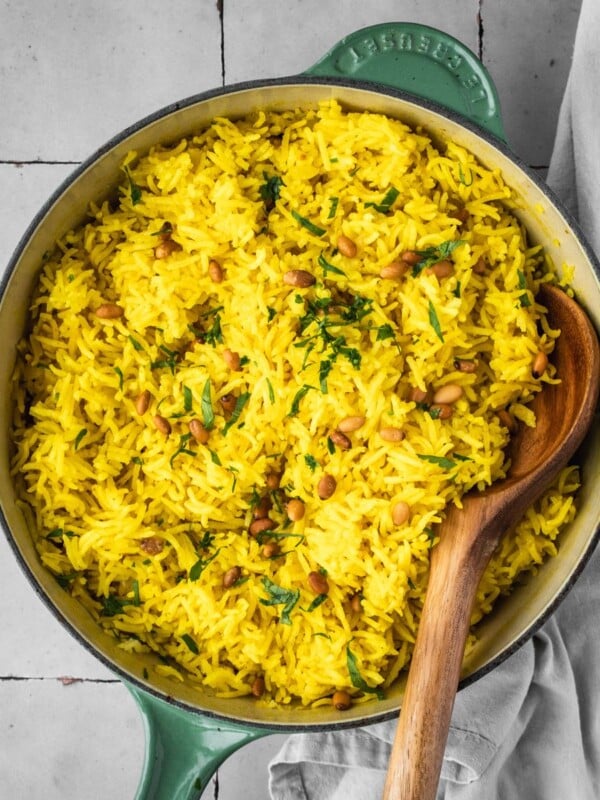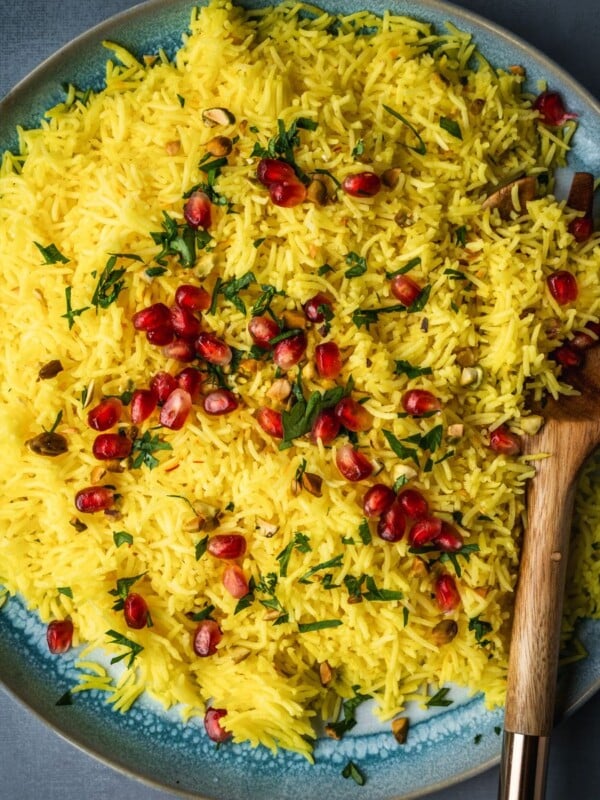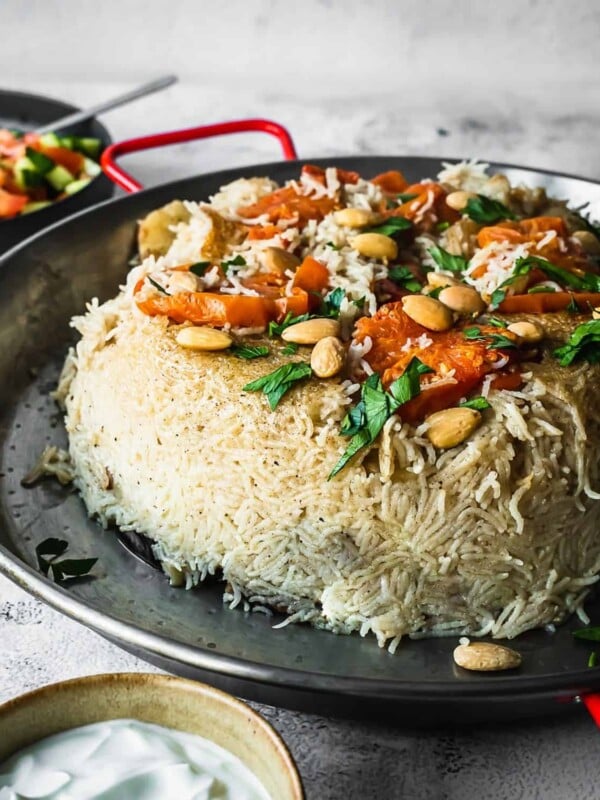Hashweh (Spiced Rice with Ground Beef) is a one-pot dish that is comforting and delicious. It can be enjoyed on its own as a main dish or served as a side or base with roasted proteins and vegetables. It combines warm Middle Eastern spices with fragrant basmati rice and ground meat.
I serve mine with Jerusalem Salad (chopped cucumber and tomato salad) and Cacik (cucumber yogurt dip).

Table of Contents
What is Hashweh?
Hashweh, which translates to “stuffing” in Arabic, is a spiced rice dish commonly found in Middle Eastern and Levantine cuisine. Traditionally, it’s used as a filling for dishes like roasted chicken, lamb, or even grape leaves.
However, it’s just as delicious served on its own as a one pot meal, garnished with toasted nuts and fresh herbs. The dish features fragrant basmati rice cooked with ground beef (or ground lamb) and a blend of warm spices, creating a deeply savory and aromatic meal.
Many families have their own versions of Hashweh, adapting it based on available ingredients and personal taste. This recipe here is the one I grew up with. If you’re a fan of flavorful, spiced rice recipes try my Mediterranean Yellow Rice and Qidreh (Lamb and Rice).
Ingredients
This isn’t a complicated recipe and the ingredients are quite common. You shouldn’t have any trouble sourcing these simple ingredients, and you probably have everything you need on hand already.

- Beef: I am using lean ground beef. You can use extra lean ground beef if you prefer to cut down on the fat content. You can also use ground chicken, ground lamb or ground turkey. If you are feeling more up for the task, you can hand chop a piece of top sirloin into small cubes. But honestly, just go with the ground beef! Let’s not complicate our lives!
- Spices: You will need the quintessential spice blend used in Middle Eastern cuisine, Baharat (also known as 7-Spice or Lebanese 7-Spice). You can purchase the spice blend from any Middle Eastern grocery store, or you can substitute with equal parts ground cumin, ground coriander and cinnamon. That’ll get you the closest to the authentic flavor profile.
- Rice: My go-to rice variety for most, if not all, of my Levantine recipes is Basmati rice. It’s easy to cook, flavorful, fragrant and if cooked properly, really fluffy. But if you prefer a different type of rice, like Jasmine rice or Calrose, use that. Adjust the rice-to-broth ratio accordingly. Also, try my Vermicelli Rice, Tahdig (Crispy Persian Rice) and Saffron Rice recipes.
- Liquid: Chicken stock gives the finished rice a really nice flavor. You can make your own stock, or use boxed. I prefer a lower sodium option.
Refer to the recipe card at the bottom of this page for the full list of ingredients and quantities.
How to Make this Hashweh Rice Recipe
The recipe is quite straightforward, but I always recommend you read through all the steps to get your bearings before starting.

Step 1. Rinse the Rice. Start by rinsing the basmati rice under cold water until the water runs clear. This removes excess starch and helps prevent the rice from becoming sticky. Let it drain in a sieve set over a bowl.

Step 2. Sautee the Beef. Place a large pot on medium-high heat and add the olive oil. When the oil heats up, add the ground beef, salt and black pepper. Cook until the beef is cooked through and most of the liquid has evaporated, about 7-10 minutes. Keep stirring with a wooden spoon throughout the process, scraping any bits that stick to the bottom of the pan.

Step 3. Add the Aromatics. Add the diced onion, minced garlic and 7-spice to the beef. Sautee to toast the spices and soften the onion, about 2-3 minutes. The onion should be slightly translucent but not fully cooked.

Step 4. Add the Rice. Add the rinsed and drained rice to the seasoned meat mixture. Stir to coat.

Step 5. Add the broth. Add the chicken broth to the pot, stirring well to make sure there are no clumps of rice.

Step 6. Cook. Place a tight-fitting lid on the pot and bring it to boil. As soon as the pot boils, turn the heat down to the lowest setting. Simmer for 20-25 minutes.

Step 7. Fry the Nuts. While the rice steams, fry the nuts (pine nuts and/or almonds) in a small pan with butter on medium heat. Be careful, the nuts will burn quickly. This shouldn’t take any longer than 1-2 minutes.

Step 8. Rest and Serve. Let the rice rest off the heat for 10 5-10 minutes before serving. Garnish with chopped fresh parsley and toasted nuts.
Expert Tips
- Rinse and Soak the Rice. Don’t skip this step! Rinsing removes excess starch, preventing the rice from becoming sticky, while soaking helps it cook more evenly. We want fluffy rice after all!
- Use Freshly Ground Spices. If possible, use fresh spices. Listen, I get it, I have some spices in my pantry that are several years old! Ideally, you would replace your spices every year but that’s not always an option.
- Don’t Overcrowd the Pot. If doubling the recipe, use a wide pot to ensure even cooking. Remember that the rice will expand as it steams.
- Adjust the Liquid Ratio. Depending on your rice brand, you may need slightly more or less liquid. Start with the recommended amount and adjust as needed.
- For Extra Flavor. Brown the ground beef well to build a deeper, richer taste. That caramelization is worth the effort.
- Fun Additions. Though not really traditional, you can add some chopped carrots, peas or green beans to the recipe. A cup of frozen vegetable medley makes the recipe more substantial. You can also add golden raisins (totally optional, not every family does this).

Serving Suggestions
Hashweh is fantastic on its own but pairs beautifully with a side of yogurt, a side salad (like my Jerusalem Salad or Authentic Lebanese Fattoush), or roasted vegetables. Try it with my Mint Yogurt sauce or Cacik (Turkish cucumber yogurt dip).
As mentioned earlier, Hashweh is often used to stuff whole chickens. Stuffed chicken is a very important recipe for Palestinians, often served for special occasions or celebrations. You can serve this seasoned rice as a side dish with roast chicken, or even a pre-made rotisserie chicken from the grocery store.
If you’re for it, try making your own Middle Eastern Style chicken broth using a whole chicken and serve the chicken along with the rice.

Troubleshooting Common Issues
- If the rice is wet once it’s finished, leave the lid off for 5-10 minutes and let it steam.
- If the rice is undercooked, add a splash of water or broth, cover, and let it cook for another few minutes.
The key here is to use the kind of rice you are comfortable with and have used before. If you have cooked with basmati before and you know the water ratio that works for you, stick to it.
Recipe FAQs
Yes! Hashweh keeps well in the fridge for up to 3 days. Store it in an airtight container and reheat gently on the stovetop or in the microwave with a splash of water to prevent drying out.
Absolutely. Allow the cooked rice to cool completely, then store it in a freezer-safe container for up to 3 months. Thaw in the fridge overnight before reheating.
Other Rice Recipes
Appetizers
Levantine Recipes
Levantine Recipes
Levantine Recipes
If you make this Hashweh (Spiced Rice with Ground Beef) Recipe or any other Levantine Recipe on Urban Farm and Kitchen, please take a moment to rate the recipe ⭐⭐⭐⭐⭐ and leave a comment below. It’s such a help to others who want to try the recipe.
For more Urban Farm and Kitchen, follow along on Instagram, Facebook, and Pinterest, visit the Urban Farm Shop, or subscribe for new posts via email.
Hashweh (Spiced Rice with Ground Beef)

Ingredients
- 1½ cups Basmati rice
- 2 tbsp Olive oil
- 1 lb Lean ground beef
- 1 tsp Kosher salt
- ½ tsp Black pepper
- 1 Onion (finely chopped)
- 1-2 Garlic cloves (finely minced)
- 2 tsp Baharat spice blend – Substitute with ¾ teaspoon cumin, ¾ teaspoon coriander, ½ teaspoon cinnamon
- 2¼ cups Chicken broth
Garnish
- 2 tbsp Butter
- 2 tbsp Pine nuts and slivered almonds
- Fresh parsley
Instructions
- Rinse the Rice. Start by rinsing 1½ cups Basmati rice under cold water until the water runs clear. This removes excess starch and helps prevent the rice from becoming sticky. Let it drain in a sieve set over a bowl.
- Sautee the Beef. Place a large pot on medium high heat and add 2 tbsp Olive oil. When the oil heats up, add 1 lb Lean ground beef, 1 tsp Kosher salt and ½ tsp Black pepper. Cook until the beef is cooked through and most of the liquid has evaporated, about 7-10 minutes. Keep stirring with a wooden spoon throughout the process, scraping any bits that stick to the bottom of the pan.
- Add the Aromatics. Add 1 Onion (finely chopped), 1-2 Garlic cloves (finely minced) and 2 tsp Baharat spice blend to the beef. Sautee to toast the spices and soften the onion, about 2-3 minutes. The onion should be slightly translucent but not fully cooked.
- Add the Rice. Add the rinsed and drained rice to the seasoned meat mixture. Stir to coat.
- Add the broth. Add 2¼ cups Chicken broth to the pot, stirring well to make sure there are no clumps of rice.
- Cook. Place a tight-fitting lid on the pot and bring it to boil. As soon as the pot boils, turn the heat down to the lowest setting. Simmer for 20-25 minutes.
- Fry the Nuts. While the rice steams, fry 2 tbsp Pine nuts and slivered almonds in a small pan with 2 tbsp Butter on medium heat. Be careful, the nuts will burn quickly. This shouldn’t take any longer then 1-2 minutes.
- Rest and Serve. Let the rice rest off the heat for 10 5-10 minutes before serving. Garnish with chopped Fresh parsley and toasted pine nuts.
Notes
- Beef: I am using lean ground beef. You can use extra lean ground beef if you prefer to cut down on the fat content. You can also use ground chicken, ground lamb or ground turkey.
- Spices: You will need the quintessential spice blend used in Middle Eastern cuisine, Baharat (also known as 7-Spice or Lebanese 7-Spice). You can purchase the spice blend from any Middle Eastern grocery store, or you can substitute with equal parts ground cumin, ground coriander and cinnamon.
- Rice: My go-to rice variety for most, if not all, of my Levantine recipes is Basmati rice. It’s easy to cook, flavorful, fragrant and if cooked properly, really fluffy. But if you prefer a different type of rice, like Jasmine rice or Calrose, use that. Adjust the rice-to-broth ratio accordingly.
Nutrition
Nutrition information is automatically calculated, so should only be used as an approximation.
 Like this recipe? Rate & comment below!
Like this recipe? Rate & comment below!















I loved this. Reminded me of how my mother used to make it for us.
That means so much, thank you.